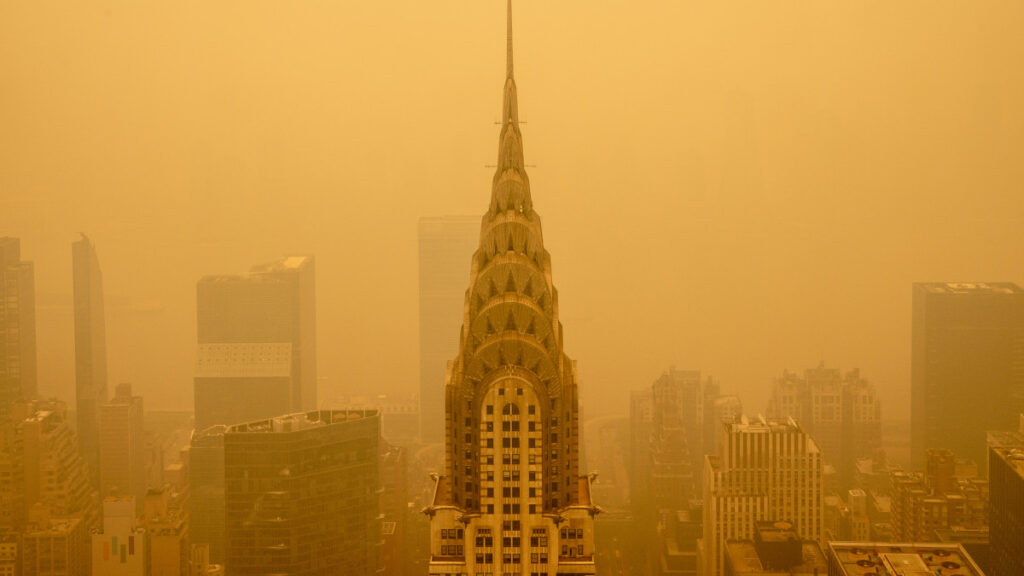Smoky wildfires from Canada have recently been affecting millions of people on the American East Coast. There are pictures of smoke and haze obscuring the New York skyline. Because of the raging wildfires on June 7th, 2023, New York and Detroit both made the list of the five most polluted cities in the world. Even though the wildfires are hundreds of miles away, they’re terrorizing the East Coast’s atmosphere, bringing unhealthy air, breathing difficulties, and a number of other problems for the past week. Ranging from delayed flights to asthma attacks to weather alerts, the wildfires have been wreaking havoc. With rising climate change concerns and the rapid depletion of the ozone layer, these wildfires are turning into a wakeup call, prompting authorities to take action to prevent further damage. The resulting smoke from the wildfires has creating numerous problems, including adverse health effects, environmental harm, and economical injury.

Injury to Health
With over a hundred wildfires blazing through Canada, the smoke and haze has triggered countless air quality alerts throughout the country’s Eastern coast. Wildfire smoke is particularly harmful for humans because it carries microscopic particles, such as PM2.5, which are 2.5 microns or smaller.
PM2.5 is a particle common not only to smoke but also vehicle emissions and other air pollution; however, wildfire smoke can be more toxic than regular smog or urban pollution. These particulate matter are small enough to travel deep inside the lungs, affecting the airways and respiratory system as a whole, not only exacerbating underlying conditions but also creating inflammatory symptoms for those without respiratory issues.
By releasing volatile organic compounds, polycyclic aromatic hydrocarbons, etc, wildfire smoke can suppress macrophage function of the alveoli, having potential effects on even the brain and cardiovascular system. PM2.5 exposure, even short-term exposure, has been linked to premature death, chronic bronchitis, asthma attacks, heart/lung conditions, respiratory symptoms, and increasing emergency/hospital visits. To prevent exposure, the best way is to stay indoors, but if it’s required to go outdoors, it’s recommended to wear a medical-grade mask or face covering, such as an N95 mask. Air quality monitors, air filters, and humidifiers can also prove to be beneficial.

Public & Economic Concerns
For people with underlying conditions, poor air quality can mean being restricted from their day-to-day activities, forcing them to stay indoors for even weeks at a time. Because of the hazardous haze conditions, businesses and public school systems are being forced to shut down. Tourism, properties, and recreation are all being demolished, with the economy plunging even deeper into ruins. Wildfires not only harm the economy, but they also severely injure ecosystems throughout the world. By leaving hydrophobic soil behind, wildfires create water-repellant land that can create recurring flash floods, burn scars, and a loss of vegetation that can last for years.

Just like with humans, animals can have respiratory inflammation, distress, and pure immune function, causing them to be severely injured or even die. Wildfires also destroy many habitats, decimating many animal and plant populations that can be crucial to the growth or balance of an ecosystem.
It’s Only Going Up
With the wildfires in California and Oregon to the recent ones in Canada, wildfires are becoming more and more common. The air quality alerts on our weather apps are becoming normal and expected on a regular basis. Hearing news reports about climate change and its devastating effects is becoming daily life. However, this is not the way it should be. Politicians and authorities around the world must take a stronger stance against remediating and preventing further damage to not only human health but also the environment. Numerous species are dying, habitats are being destroyed, water is becoming undrinkable, trees are vanishing, and oxygen levels are only going down with the rapidly overtaking carbon dioxide percentages.
The Earth is the only home we have, so we need to be more mindful of our actions and do everything to the best of our ability to reduce pollution, preserve wildlife, and protect our home.

